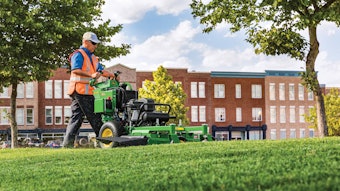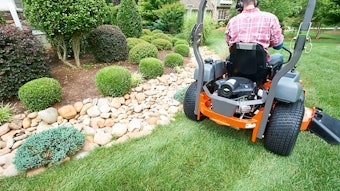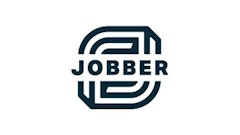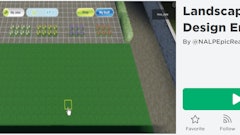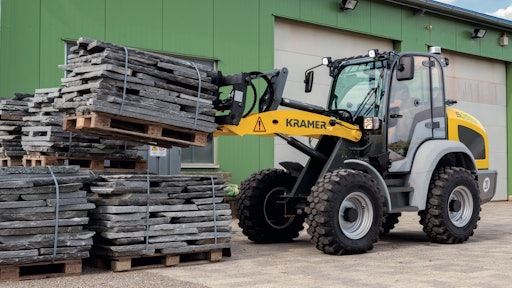
As electrification technology continues to advance, so does the range of machine types to which it’s applied. Electrically powered wheel loaders are among some of the more recent machine introductions.
For example, Wacker Neuson’s WL20e and Kramer 5055e electric wheel loaders are both part of the company’s range of emissions-free equipment, and are capable of working up to eight hours on a single charge, depending on the application. Moreover, the machines can be used inside buildings, which not only helps increase the applications and environments in which the loaders can be used, but also ensures the health and safety of those working around them.
Stefanie Wieland, head of group branding, marketing and communication at Wacker Neuson SE, says there are some areas in which vehicles with a combustion engine are completely prohibited. Because of this, the availability of electrically powered equipment is important.
In addition, the noise levels of electrically powered wheel loaders and other equipment is greatly reduced, enabling their use in residential areas and other noise-sensitive areas.
Reducing noise and emissions were major factors for Wacker Neuson’s development of its electric wheel loaders, as well as its entire range of zero-emission electric equipment.
Charging Forward
According to Wieland, the concept for the WL20e and 5055e electric wheel loaders is based on time-tested large-scale technology used in material-handling equipment. The company chose to use absorbent glass mat battery technology, which is common in forklifts. This closed and maintenance-free lead-acid battery system is specifically designed for high-demand applications. The weight of the battery provides the added benefit of serving as counterweight.
An integrated onboard charging unit means end users are not required to rely on fixed charging stations on site. Instead, they can plug the machine into an outlet and recharge the battery whenever necessary. “This offers maximum flexibility at every site of [use],” says Wieland.
The battery drives two electric motors on the loaders: one for the drive system and one for the working hydraulics. Power is automatically provided by the respective motor, which helps to minimize energy consumption.
Wieland says designing the wheel loaders in this manner ensures low operating costs and optimal battery runtimes. With an electric motor built into the drive system, high performance and tractive force can be achieved. Meanwhile, the motor for the hydraulics system delivers only the amount of power required for the application at hand, reducing unnecessary power draw.
“These motors are particularly energy efficient with degrees of efficiency from 94 to 97 percent,” explains Wieland.
Optimized for Efficiency
Efficiency is an important aspect of electric equipment. Last year, Volvo Construction Equipment presented field test results for its LX1 prototype electric hybrid wheel loader, which showed an average fuel efficiency improvement of 50 percent. It since introduced a second-generation prototype, the LX2. Like the LX1, the LX2 is part of a research project and is not commercially available.
To make the machine electric, the combustion engine was replaced with a lithium-ion battery, which stores enough electric energy to operate the machine for eight hours in its most common applications, such as light infrastructure construction and landscaping. The LX2 also incorporates dedicated electric motors for the drivetrain and for the hydraulics. Decoupling the subsystems led to higher efficiency in both the systems and the machine.
“[The LX2] incorporates the latest advanced-chemistry battery technology. As it’s electric, no particulate matter, nitrogen oxide or carbon dioxide are released into the environment,” says Ulrich Faß, Volvo Construction Equipment emerging technologies manager. “This, together with the fact that it has extremely low noise levels, makes it ideal for use in cities and densely populated areas.”
While there are no direct plans to bring it to market, the LX2 provides a demonstration of potential capabilities for the future. “Volvo Construction Equipment has long-term plans to develop products and services for electromobility, including electric hybrids and electric sites,” says Scott Young, vice president of uptime and customer support for sales.
According to Young, Volvo Construction Equipment believes there is going to be a major shift toward electric hybrid technology in the future, but end users continue to demand improved efficiency now. As such, the company plans to continue to optimize more conventional technologies, but expect to see elements of its design incorporated into these products.
“This supports short- and mid-term developments and requirements while the market continues to accept hybrid technology, as technology improves and the cost of new technologies decreases,” says Young.
Simplified Drive System
At the Green Industry & Equipment Expo (GIE+EXPO), Avant Tecno introduced its e5 fully electric battery-powered articulated loader. The e5 features a 240-Ah (11.5-kWh) lead-acid battery and two electric motors: a 6-kW motor for driving the machine, and a 2-kW motor for loader boom operation and auxiliary hydraulics.
Similar to the Wacker Neuson wheel loaders, the e5 comes equipped with an integrated battery charger for charging anywhere a 230-V/10-A power outlet is available. Operators can continue using the machine while it’s plugged in and charging. The battery is fully charged in approximately five hours, but is capable of reaching 80 percent capacity in three hours. The zero-emissions machine can be used indoors or outdoors.
Avant Tecno also offers the e6 battery-powered loader, which uses a 288-Ah (14.5-kWh) lithium-ion battery with the option of a 400-V/16-A or 400-V/32-A rapid battery charger. The company says the rapid charger considerably reduces charging time compared to the built-in charger on the e5; a 100 percent charge can be achieved within one hour.
The typical drive system in the company’s loaders consists of a variable-displacement hydraulic pump, four hydraulic drive motors (one on each wheel), and a combination of hydraulic valves, hoses and fittings. The eSeries loaders feature the Optidrive drive circuit, an updated version of this drive system.
Hydraulic oil is used to provide drive power from the machine’s 6-kW electric motor to the four hydraulic drive motors. Fewer hydraulic hoses and fittings reduce the amount of heat generated when hydraulic oil flows through, and thus reduces fuel consumption and power draw from other componentry. Avant Tecno says there are 20 percent fewer hoses and 60 percent fewer fittings.
Reducing the number of hydraulic components enables Optidrive to reduce power loss by up to 1.5 kW, roughly 10 percent of the total power used in the drive circuit. It also helps improve maintenance as there are fewer components that may need fixing or which could prohibit accessibility to other parts of the machine.
Optidrive also enables a lot of pushing power in a compact design, while maintaining a low center of gravity. It improves performance of the eSeries models by as much as 10 percent, according to the company.
More Electrics Ahead
Emissions reduction and improved efficiency are going to continue to be key drivers for equipment design for years to come. With more manufacturers applying electrification technologies to more types of equipment, there are going to be further options available for end users to get their work done while complying with evolving environmental requirements.
Sara Jensen is the editor of OEM Highway, a sister publication of Green Industry Pros.



